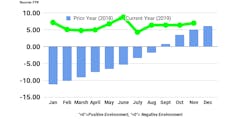FTR’s Shippers Conditions Index (SCI) for November jumped to a 7.0 reading after three consecutive months at 6.4. All index inputs were stronger in November than in October except for freight volume, which remained muted but positive.
The SCI likely is at its peak, FTR maintained, as conditions for shippers, while remaining positive in 2020, are expected to soften going forward, due primarily to firmer freight rates and tighter capacity utilization. Although unknown at this time, fuel prices could also have a negative effect on shippers’ costs if IMO 2020 and conflicts between the U.S. and Iran put pressure on them.
“Capacity is forecast to slowly tighten over the course of 2020, which will lead to slightly worsening conditions for shippers,” said Todd Tranausky, vice president of rail and intermodal at FTR. “Truck capacity is expected to slowly increase to its historical range this year, causing shippers to examine rail and intermodal alternatives as the increased truck utilization pushes truck rates higher and makes alternatives more attractive.”
The January issue of FTR’s Shippers Update details the factors affecting the November Shippers Conditions Index. Also included in January is a discussion of the possible impacts of coming regulatory changes at the state, national and global levels.
FTR’s SCI tracks the changes representing four major conditions in the US full-load freight market: freight demand, freight rates, fleet capacity and fuel price. The individual metrics are combined into a single index that tracks the market conditions that influence the shippers’ freight transport environment.
A positive score represents good, optimistic conditions. A negative score represents bad, pessimistic conditions.
